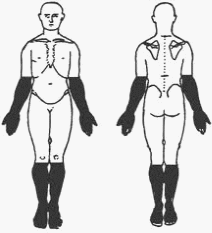Polyneuropathy
Search Cidpusa web Help for all diseases
Sat, 31 May 2008 17:55:07
By IMRAN KHAN, MBBS.,
Peripheral Neuropathy Fact Sheet

What is peripheral neuropathy?
Peripheral neuropathy describes damage to the peripheral nervous system, the vast communications network that transmits information from the brain and spinal cord (the central nervous system) to every other part of the body. Peripheral nerves also send sensory information back to the brain and spinal cord, such as a message that the feet are cold or a finger is burned. Damage to the peripheral nervous system interferes with these vital connections. Like static on a telephone line, peripheral neuropathy distorts and sometimes interrupts messages between the brain and the rest of the body.
Because every peripheral nerve has a highly specialized function in a specific part of the body, a wide array of symptoms can occur when nerves are damaged. Some people may experience temporary numbness, tingling, and pricking sensations (paresthesia), sensitivity to touch, or muscle weakness. Others may suffer more extreme symptoms, including burning pain (especially at night), muscle wasting, paralysis, or organ or gland dysfunction. People may become unable to digest food easily, maintain safe levels of blood pressure, sweat normally, or experience normal sexual function. In the most extreme cases, breathing may become difficult or organ failure may occur.
Some forms of neuropathy involve damage to only one nerve and are called mononeuropathies. More often though, multiple nerves affecting all limbs are affected-called polyneuropathy. Occasionally, two or more isolated nerves in separate areas of the body are affected-called mononeuritis multiplex.
In acute neuropathies, such as Guillain-Barré syndrome, symptoms appear suddenly, progress rapidly, and resolve slowly as damaged nerves heal. In chronic forms, symptoms begin subtly and progress slowly. Some people may have periods of relief followed by relapse. Others may reach a plateau stage where symptoms stay the same for many months or years. Some chronic neuropathies worsen over time, but very few forms prove fatal unless complicated by other diseases. Occasionally the neuropathy is a symptom of another disorder.
In the most common forms of polyneuropathy, the nerve fibers (individual cells that make up the nerve) most distant from the brain and the spinal cord malfunction first. Pain and other symptoms often appear symmetrically, for example, in both feet followed by a gradual progression up both legs. Next, the fingers, hands, and arms may become affected, and symptoms can progress into the central part of the body. Many people with diabetic neuropathy experience this pattern of ascending nerve damage. top
How are the peripheral neuropathies classified? More than 100 types of peripheral neuropathy have been identified, each with its own characteristic set of symptoms, pattern of development, and prognosis. Impaired function and symptoms depend on the type of nerves-motor, sensory, or autonomic-that are damaged. Motor nerves control movements of all muscles under conscious control, such as those used for walking, grasping things, or talking. Sensory nerves transmit information about sensory experiences, such as the feeling of a light touch or the pain resulting from a cut. Autonomic nerves regulate biological activities that people do not control consciously, such as breathing, digesting food, and heart and gland functions. Although some neuropathies may affect all three types of nerves, others primarily affect one or two types. Therefore, doctors may use terms such as predominately motor neuropathy, predominately sensory neuropathy, sensory-motor neuropathy, or autonomic neuropathy to describe a patient's condition. Though CIDP is the most common treatable neuropathy.
What are the symptoms of peripheral nerve damage?
Symptoms are related to the type of affected nerve and may be seen over a period of days, weeks, or years. Muscle weakness is the most common symptom of motor nerve damage. Other symptoms may include painful cramps and fasciculations (uncontrolled muscle twitching visible under the skin), muscle loss, bone degeneration, and changes in the skin, hair, and nails. These more general degenerative changes also can result from sensory or autonomic nerve fiber loss.Vitamin-C
Vitamin D Deficiency
Serotonin Deficiency
Axonal EMG
SLE & GENES
Toxic Baby Car Seats
Toxic Pesticide
Under active thyroid
Bay Leaves
More Spices
7 Habits of Covy
MagneticFieldMap
MS GENES
Polymyalgia
Polymyositis
Dematomyositis
Natural Diet for diseases
Lower Cholesterol
Homocysteine Lowering diet
Hemodialysis Diet
Iodine deficient diet
Food additives
No artificial sweetener in diet
Loss of appetite